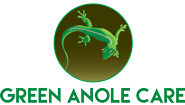Green Anole Care Tips
Why is my anole changing colors?
Generally speaking, scientists have no idea. The only trend I have personally witnessed is that a submissive anole is always brown — but a brown anole is not always submissive. “A green anole is a happy anole” is not a true statement — some green anoles spend most of their lives brown and still live full, healthy lives.
Don't mix species!
Even two species of Anoles should NOT be kept in the same enclosure. Why? Besides that fact that different species generally have different environmental requirements, each reptile species has its own parasite load. Some are beneficial and some are harmful but all reptiles and amphibians have some microbe or parasite living in their digestive tract. What is completely benign and innocuous to one species might very well be fatal to another. If you mix species, you will shorten the lifespan of both.
Dealing with unshed bits of skin
Generally speaking, unshed bits of skin are not a problem unless they are obstructing growth of an appendage. NEVER remove unshed skin forcefully — if it is necessary to remove the best approach is a gentle application of a Q-Tip, dipped in warm water, to the area where unshed skin is present.
Gender identification
Most methods of green anole identification are unreliable. The ONLY reliable method identification is the anole’s postanal scales. A pair of enlarged postanal scales indicate a male anole. Mature anoles are easier to identify as mature males have a hemipenile bulge at the base of their tail.
What's up with the white stuff around my anole's nostrils?
No worries! Anoles don’t sweat — instead they excrete excess salt, often through their mouth and noses. It looks might look weird at first, but it’s normal!
Environment:
Keep an extra terrarium!
Most folks start out with a terrarium / aquarium / vivarium which is too small, and they get rid of the original when it is replaced. Deep cleaning your terrarium will be much, much easier and less traumatizing to your anoles if you opt to transfer them into another terrarium while the cleaning takes place. The extra terrarium can also serve as a quarantine terrarium if you find a new anole, or if one of your gets sick.
Use regular incandescents, not speciality bulbs for heating
Generally speaking, specialty reptile heating bulbs are several times as expensive and no more if not less reliable than regular incandescents. Monitor basking spot and cool side temperatures to ensure they are correct (85F – 92F for basking, 70F – 76F for cool side). Make sure use a UVB bulb alongside your heating bulb.
Avoid substrate with indigestible material
This type of material can lead to intestinal impaction if the anole accidentally consumes it while feeding. This includes the following: sand, ground Walnut hulls, corncob refuse, moss, bark products, pebbles, gravel, etc.. The best substrate is organic potting soil or organic compost without perlite or fertilizer.
Diet / Feeding:
Feeding schedule
I feed my anoles four times per week using a diet primarily consisting of crickets, wax worms and occasionally other small insects. I feed them until they are no longer interested in eating anymore, doing my best to remove any live insects from the terrarium before night time.
Remove live feed before night time!
To keep your anoles safe and interested in prey items (anoles tend to be more interested in newly introduced prey), it is highly recommended that you remove live feed from the terrarium before night time. In the event this is impossible or very difficult (crickets can be elusive), make sure there is cricket food left in the terrarium so the crickets don’t go after your anoles instead.
Consider raising / catching insects
When first starting out, it is easiest to acquire live feed from local pet stores. However local pet stores don’t always provide a diverse diet for our anoles, nor are they the most economical option. Once you’ve leveled up your green anole skills a bit, consider our guides on Raising Insects / Catching Insects!
